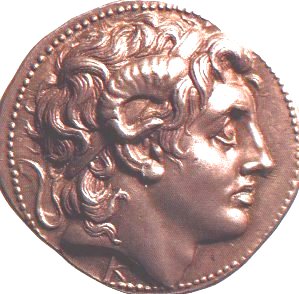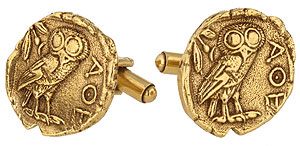The Production of Coins
Coin production began in the late seventh century BCE, and the technique for production changed little from then until the seventeenth century CE. The coin press consisted of six parts: the anvil, obverse die, coin blank, reverse die, punch, and hammer. The anvil supported the obverse die upon which the coin blank, heated to make it malleable, was set. The reverse die, attached to the punch was then pounded into the coin blank with the hammer. The shape of the coin was not extremely important—often the coins were somewhat irregularly shaped. What was critical, however, was the weight of the coin. Though standards for each type of coin varied from region to region, the weights had to match the regions standard exactly. As a result, the coin-maker often would shave off bits of the coin blank to make it the proper weight, making the coins even more irregularly shaped.
The Relevance of Coins
Coins are some of the most dynamic artifacts from ancient history because of their unique relationship to the people of a civilization. Unlike many other items recovered from the past, coins do not generally have a single owner. They change hands frequently as they are exchanged for goods, and can therefore reveal trade interactions between different regions. Additionally, in some cases changes in currency be a result of other historical events. One such case is the shift from the silver standard to gold in Athens. This was a response to a depletion of silver sources due to the high cost of the Peloponnesian war.
The signature designs of coins change over time, often revealing cultural shifts. One such case is the introduction of an image of Alexander the Great to coins in Macedonia. This was the first case where a ruler, rather than a god, was pictured on a coin. In a sense, Alexander was suggesting that he was a god, and using the coin as a form of propaganda. The image of a ruler on a coin has proved to be an enduring trend—from Ancient Rome to many modern societies.
Below: A Macedonian coin depicting Alexander the Great
(http://www.livius.org/a/iran/wall/alexander.html)

Aside from its relevance in relation to the past, ancient coins have a special importance in the present. Coins are among the only ancient artifacts which can be accessed by ordinary people. Coins are an everyday part of life and are therefore plentiful. So while sculpture and other artwork often ends up in museums, coins often fall into the hands of individual collectors. Coins also are more likely to be found intact than other common items such as pottery, which breaks easily, and textiles, which are destroyed over time. With the rise of the internet, ancient coins have become even more accessible, since one no longer has to seek out a dealer. One can even look on eBay and discover a variety of ancient Greek coins for an incredible range of prices.
Below: A pair of cufflinks made to resemble ancient gold Athenian coins.
(http://www.metmuseum.org/store/st_beautyShop_Page.asp/familyID/%7BEEA791D1-EF65-4330-8D07-598837133557%7D/FromPage/catNeckTies/catID/%7B408E1466-8C4B-4EBC-8357-21918369F983%7D/familyNo/callFromRelViewer/SpecialPermFlag/FromSearch/)

Sources: Jenkins, G.K. Ancient Greek Coins (New York: G.P. Putnam's Sons, 1972). Kraay, Colin M. Archaic and Classical Greek Coins (London: Methuen and Co. LTD, 1976).
Posted at Dec 11/2007 10:22PM:
keffie: Excellent use of our contemporary engagement with these ancient materials.
